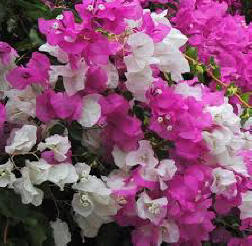cultivation practices
-
climate and spacing
Well-drained, slightly acidic (pH 5.5-6.0) with good aeration and drainage is ideal. Avoid soil mixes with high peat levels and water retention. Bouganvillea grow best in full sun. High light intensity is required for good flowering. Low light and shady areas are not suitable, as the plants will drop their bracts.
-
propagation and media
Bougainvillea roots best from semi-hardwood cuttings with 5-9 nodes in length.
Bougainvillea has an extremely fine root system, and should be planted in well-drained soils. It takes 6-12 weeks for rooting. Transplant young plants with caution to avoid damaging the roots, and always apply a broad-spectrum fungicide drench when planting cuttings and again after transplanting to prevent root rot.
-
Plant growth regulators
To induce lateral branching, applications of BA (benzyl adenine) at 50–100 ppm can be made when the plant tips are pinched back. Apply one spray 24 hours after the first pinch and another spray 24 hours after the second pinch. Dikegulac sodium at 14 g/litre can be used for second pinch-plus-BA application to improve branching.
-
irrigation and flowering
Bougainvillea tolerates drought and if possible irrigation should be adjusted to be a little on the dry side. They are sensitive to overwatering but should not be allowed to completely dry out.
Blooms occur only on new growth, so new growth on plants is vital to the achievement of flowering. Bougainvillea normally flowers during the short days of winter, but blooms are highly dependent on temperature.
-
fertilizer
Bougainvillea needs regular fertilizing with formulations having NPK ratios of 1:1:1 or 2:1:2. Applications of soluble minor elements help prevent leaf chlorosis. Micronutrient applications can be half the recommended rate, twice a year.
-
pruning
Regular pruning is necessary to shape the plant and direct its growth because the shoots often grow vigorously. Flowers are borne on new growth, so pinching back and pruning is necessary to induce new growth. Pruning should be done after flowering has finished, as this encourages the new growth on which the next flush of flowers will occur.

